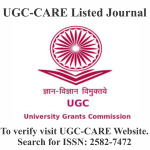THE TRANSFORMATIVE POTENTIAL OF YOGA IN ORGANIZATIONS
DOI:
https://doi.org/10.29121/shodhkosh.v5.i6.2024.6519Keywords:
Yoga, Corporate Wellness, Stress Management, Emotional Intelligence, Productivity, Organizational CultureAbstract [English]
Yoga's transformative potential is increasingly recognized in corporate settings, offering a holistic approach to enhancing individual and organizational well-being. This paper explores the multifaceted benefits of integrating yoga into the workplace, examining its impact on both employees and the overall organizational environment. For individuals, yoga provides effective stress management techniques, leading to reduced anxiety, burnout, and improved overall psychological health. Furthermore, regular yoga practice enhances focus, concentration, and cognitive function, contributing to increased productivity and improved decision-making. Beyond the cognitive benefits, yoga cultivates emotional intelligence, self-regulation, and self-compassion, fostering a more positive and resilient workforce. The physical benefits of increased flexibility, strength, and balance contribute to overall well-being and reduced health-related costs.
At the organizational level, yoga fosters a more positive and supportive work environment, leading to increased employee engagement and job satisfaction. By promoting a sense of community and connection, yoga enhances teamwork and collaboration, while also fostering creativity and innovation through a more open and receptive mindset. Moreover, yoga's emphasis on mindfulness and ethical conduct can positively influence organizational values and promote sustainable business practices. This paper also addresses the practical considerations of implementing yoga programs in the workplace, including various formats, creating a supportive environment, and measuring program effectiveness. Ultimately, this exploration highlights the transformative potential of yoga to create a healthier, more productive, and ethically conscious corporate culture.
References
Hartfiel N, Burton C, Rycroft-Malone J, Clarke G, Havenhand J, Khalsa SB, Edwards RT (2012) Yoga for reducing perceived stress and back pain at work. Occup Med 62(8):606-612. https://doi.org/10.1093/occmed/kqs168
Wolever, R. Q., Bobinet, K. J., McCabe, K., Mackenzie, E. R., Fekete, E., Kusnick, C. A., & Baime, M. (2012). Effective and viable mind-body stress reduction in the workplace: A randomized controlled trial. Journal of Occupational Health Psychology, 17(2), 246-258. DOI: https://doi.org/10.1037/a0027278
Mulla, Z. R., & Krishnan, V. R. (2014). Karma-Yoga: The Indian model of moral development. Journal of Business Ethics, 123(2), 339-351. DOI: https://doi.org/10.1007/s10551-013-1842-8
Berry, L. L., Mirabito, A. M., & Baun, W. B. (2010). What's the hard return on employee wellness programs? Harvard Business Review, 88(12), 104-112.
Hartfiel, N., Burton, C., Rycroft-Malone, J., Clarke, G., Havenhand, J., Khalsa, S. B., & Edwards, R. T. (2012). Yoga for reducing perceived stress and back pain at work. Occupational Medicine, 62(8), 606-612. DOI: https://doi.org/10.1093/occmed/kqs168
Gerbarg, P. L., Jacob, V. E., Stevens, L., Bosworth, B. P., Chabouni, F., DeFilippis, E. M., Warren, R., Trivellas, M., Patel, P. V., Webb, C. D., Harbus, M. D., Christos, P. J., Brown, R. P., & Scherl, E. J. (2015). The effect of breathing, movement, and meditation on psychological and physical symptoms and inflammatory biomarkers in inflammatory bowel disease: A randomized controlled trial. Inflammatory Bowel Diseases, 21(12), 2886-2896. DOI: https://doi.org/10.1097/MIB.0000000000000568
Pascoe MC, Thompson DR, Ski CF (2017) Yoga, mindfulness-based stress reduction and stress-related physiological measures: a meta-analysis. Psychoneuroendocrinology 86:152-168. https://doi.org/10.1016/j.psyneuen.2017.09.008 DOI: https://doi.org/10.1016/j.psyneuen.2017.08.008
Vallath, N. (2010). Perspectives on yoga inputs in the management of chronic pain. Indian Journal of Palliative Care, 16(1), 1-7. DOI: https://doi.org/10.4103/0973-1075.63127
Hartfiel, N., Havenhand, J., Khalsa, S. B., Clarke, G., & Krayer, A. (2011). The effectiveness of yoga for the improvement of well-being and resilience to stress in the workplace. Scandinavian Journal of Work, Environment & Health, 37(1), 70-76. DOI: https://doi.org/10.5271/sjweh.2916
Tan CM (2012) Search inside yourself: the unexpected path to achieving success, happiness (and world peace). HarperOne, New York
Turmel MS, Lamothe J, Daneault JG (2022) Impact of yoga practice on sleep quality in healthcare workers during COVID-19 pandemic: a systematic review. Sleep Med Rev 64:101654. https://doi.org/10.1016/j.smrv.2022.101654 DOI: https://doi.org/10.1016/j.smrv.2022.101654
Sharma, M. (2018). Yoga as an alternative and complementary approach for stress management: A systematic review. Journal of Evidence-Based Complementary & Alternative Medicine, 19(1), 59-67. DOI: https://doi.org/10.1177/2156587213503344
Lombardo C, Badin E, Carugno A, Mora M, Colombo P, Rossi A, Castronovo V (2024) Sleep quality improvement through yoga practice: a systematic review and meta-analysis. J Sleep Res 33(2):e13012. https://doi.org/10.1111/jsr.13012
Downloads
Published
How to Cite
Issue
Section
License
Copyright (c) 2024 Rupesh Vitthal Thate, Dr. Shreekala P. Bachhav

This work is licensed under a Creative Commons Attribution 4.0 International License.
With the licence CC-BY, authors retain the copyright, allowing anyone to download, reuse, re-print, modify, distribute, and/or copy their contribution. The work must be properly attributed to its author.
It is not necessary to ask for further permission from the author or journal board.
This journal provides immediate open access to its content on the principle that making research freely available to the public supports a greater global exchange of knowledge.




















